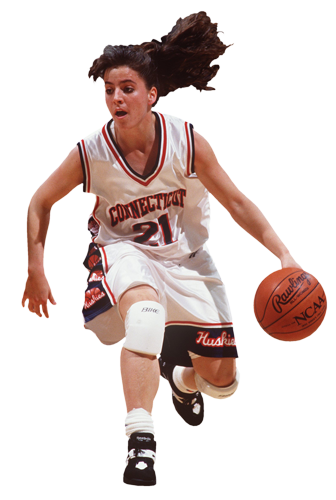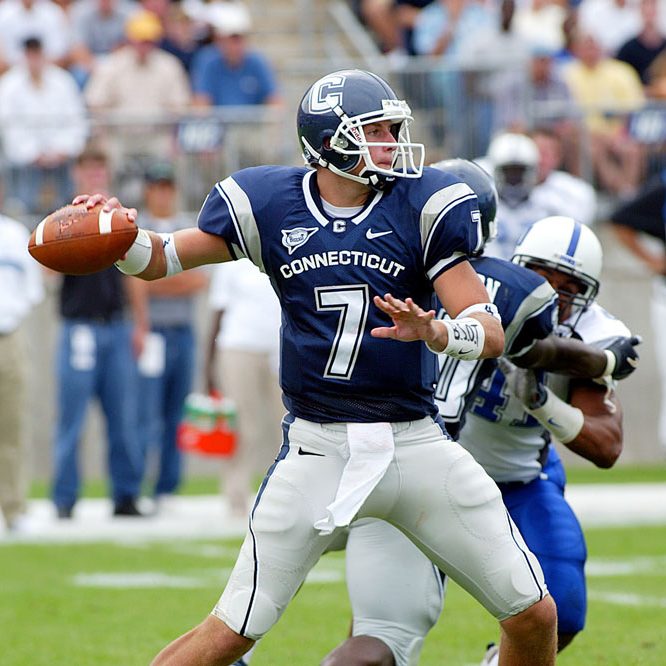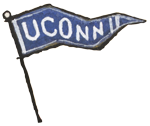The
Future
Of
(Almost)
Everything
(According to our incredibly talented, altogether brilliant, highly accomplished alums)
By Kevin Markey
No matter where you live or work, it's safe to say 2017 felt a bit topsy-turvy. At the beginning of this new year we thought we'd ask alums in various businesses what they think the future holds for their particular industry, be it education, finance, entertainment, or space exploration.
What does the future look like from your perch? Send your predictions to futurestate@uconn.edu, and we'll add them to the mix.
Education
Whither the University?
Scott S. Cowen '68 Business
President Emeritus and Distinguished University Chair of Tulane University, Cowen was instrumental in rebuilding the university — and the city of New Orleans — after Hurricane Katrina; the former chair of the Association of American Universities was named one of the nation's ten best college presidents by Time magazine
"We're undoubtedly at a tipping point in higher education. I don't think our system is broken, but it's time for unsentimental self-reflection and courageous action. If higher education leaders across the country don't face the new realities — changing demographics and an unsustainable financial model that relies on tuition amid escalating expenses and state funding cuts, to name just a couple — many of our institutions will find themselves fighting for their existence. The arms race for resources and prestige is undermining the missions of our public and private institutions alike and distracting us from the real work: educating engaged citizens and leaders; making higher education accessible to more than the already privileged and a few lucky ones; creating campuses that reflect our diverse society and that are more concerned with the benefit than the cost of inclusiveness, namely diversity of thought."

Talent Meets Opportunity
Rowena Ortiz-Walters '96 Chemistry, '05 Ph.D. Business Administration
Dean of School of Business and Economics, SUNY Plattsburgh
"At SUNY Plattsburgh, we have started a Center for Cybersecurity and Technology (CCT) within the School of Business and Economics.
Part of the motivation for the CCT is to recruit female and racial minority students, because career opportunities in cybersecurity have exploded but current trends point to a general talent shortage with women and racial minorities significantly more underrepresented.
Continued access to mentors and role models or 'direct influencers' is needed, which we can provide through the CCT. Beyond this, once in the profession, sponsors are critical for the promotion of female and minority cybersecurity leaders."
New Tricks for Old Dogs
Frances Trelease '83 Psychology, '96 MBA
Founder and president, Boomer Den, LLC, an agency that empowers adult workers through internships and job-placement services
"The idea first caught on a couple years ago, with the popularity of the movie 'The Intern.' In that film, A-list actor Robert De Niro plays a retired professional who accepts an internship with a trendy online fashion company to sharpen his skills and stay engaged. By the end of the film — as you might have guessed — De Niro earns his stripes as a valued team player who is looked to for his temperance and wisdom when chaos erupts.
The hit film brought to light the concept of reverse mentoring — millennials providing tutelage and guidance to their older counterparts in the workplace. It isn't a new concept, but it's rising to the surface as retired or downsized professionals seek novel ways to reenter the workforce. It plays off the 'traditional' apprenticeship model, where a young trainee learns a craft or trade under the watchful eye of an older, more experienced worker.
Jack Welsh, former CEO of General Electric, is widely credited with introducing the concept to the U.S. in 1999, when he charged his top officials with finding junior mentors to teach them the latest technologies. He was on to something, those 17 years ago.
According to U.S. Census Bureau projections, 'the proportion of Connecticut's population that is 60 and older is growing more rapidly than other sectors of the population.' The Bureau estimates that nearly 26 percent of Connecticut's population will be 60 and older by the year 2030.
So for Connecticut's aging workers, reverse mentoring makes good sense. Many have been phased out of jobs before they felt ready to go. Others voluntarily retired, but still have much to offer. But they face a changing work environment.
For many, today's millennials hold the key to the knowledge and skills needed to succeed in fields like social media marketing and applications development.
The younger set, in turn, gains insight into strategy, negotiation skills and 'macro' views of the big picture. They become groomed to step into leadership roles when their time comes.
Who wins from this emerging trend? Both groups do. Intellectual property continues to be the single biggest asset of corporations across the U.S. In Connecticut alone, service giants such as United Technologies Corp., The Hartford, and Stamford-based Deloitte rely on the best and the brightest minds to innovate, create, and outpace the competition — minds that range anywhere from 25 to 75 years old.
Lisa Bonner is director of Change Management & Communications at Cigna in Hartford. In a recent TEDx talk, she spoke of the value of the younger set sharing social media and mobile technology knowledge with Cigna's 'senior leaders.' Bonner described 'putting a 25 year old in the chairman's office' as a 'leap of faith "¦ but I knew we were going on to glory. It was difficult to take that step, but we did it. Once they opened up with each other, that's when the magic started to happen.'
Other benefits to reverse mentoring include improved morale and retention across the generations. And there's so much more to be done. Initiatives such as the Platform to Employment in Bridgeport provide to qualifying employers if they bring on unemployed — often senior — people for eight-week training internships. The hope is that those employers will hire these men and women full-time when the internships end.
Independent forecasters estimate that half our U.S. workforce will be made up by workers born in the mid-1980s or later. It's time in Connecticut to bridge generational gaps. It's time we take a step back, and then a solid leap forward, toward pooling our talents for mutual gain."
SPORTS
She's Got Game
Jennifer Rizzotti '96 Biology
Head coach women's basketball, George Washington University; NCAA champion, AP Player of the Year, two-time WNBA champion
"I think women's basketball is in pretty good shape right now. I think that there was a lot of excitement in the college game last year, both with UConn's win streak and obviously the big upset in the Final Four. The women's national team has won six consecutive gold medals and the WNBA's level of competitiveness is higher than it has ever been. So, I think we are in a pretty healthy state but there is always room to grow. As a coach, and the president of the Women's Basketball Coaches Association, I can say we are focusing a lot on professional development for young coaches in the game. Whether it is at the youth level, the collegiate level, or somewhere in between, for our game to get better we need the players to be better. So, therefore, it falls on our shoulders.

I think there are a lot of really talented players in college basketball right now. You see someone like Asia Durr at Louisville who had 47 points the other day. We've got Kelsey Mitchell at Ohio State who is capable of breaking scoring records and A'Ja Wilson at South Carolina who is coming off a National Championship and was the Most Outstanding Player at the Final Four. And, of course the trio, or maybe even the quartet, of UConn players that will likely be on the All-America Team. There are just a lot of really good and exciting players in the college game. When you think about the WNBA Draft next summer and the kids that are coming out of college who will be able to make an immediate impact on the WNBA teams they get drafted to, that means the game is in a healthy place.
I don't think we will be happy to maintain the level that we are at. There definitely needs to be growth in attention, attendance numbers, and television exposure. We need to be more creative in the marketing of our stories. Women's basketball itself is a great product but I also think there are so many great stories behind the game that we need to do a better job of getting out into the public. I think if we can continue to grow at a consistent rate, even if it is a slow rise, and be consistent every year we will grow the game to be bigger and better than ever. Bringing more attention to the game and our athletes, having more role models, and more women speaking out about things that are important to them are steps we can take to help this. I think we are in a good place but there is the potential in the next few years to take an even bigger step forward."
Who's the Next Tom Brady?
Dan Orlovsky '17 General Studies, QB 2001-2005
NFL quarterback, retired; UConn career record holder in pass completions, yards passing, touchdown passes, and total yards
"The quarterback position in the NFL always has been and always will be the premier position in the league, and arguably all of professional sports. Quarterbacks have always come in all shapes, sizes, and abilities, and that fact is more present nowadays than ever before. The NFL has tall QBs who would stand out in a room just because of their physical presence. And the NFL has smaller QBs with an 'everyday guy' look who could get lost in a crowd. There are guys who can throw the ball a mile and guys who probably don't even have the best arm on their teams. Contrary to a lot of talk, I don't believe the position is evolving much now from what it used to be. Yes, there are a lot of athletic guys playing the position, but there have always been athletic guys playing the position. What will never change are the essential skills a quarterback must have to be successful. Great leadership, natural arm talent, the ability to be accurate, intelligence, the ability to process information quickly, the ability to throw the football with timing. Quarterbacks must be mentally and physically tough, and they must love the big moment. No matter what one's athletic greatness or limitations may be, these traits always have been and always will be essential to quarterbacking in the NFL."

Going for Gold
Timothy P. Shriver '97 Ph.D. Special Education
Chairman, Special Olympics
"The timing is right for the Special Olympics movement to become a metaphor of and a trigger for confronting the cultural challenge of our time: how human beings can learn to welcome differences and celebrate unity. The toxin in the world today — the 'attitude of mass destruction' — is the perception that those who are different among us must be excluded, thwarted, hated, demonized. The alternative is the joy of seeing in others beautiful and heart-opening versions of ourselves, a part of our culture, a part of our history which we have hidden or shamed or feared. When given safe space, that part of us can come out and help us all to heal, grow, be more joyful and most importantly, be unified. It is time for an inclusion revolution, and the athletes of the Special Olympics will be the leaders in erasing the lines that divide us."

Now Playing
Mike Soltys '81 Communications
VP, Corporate Communications, ESPN, overseeing publicity for ESPN, ESPN2, ESPN on ABC, ESPNEWS, ESPN's college networks, and ESPN Radio
"Personalization in media will continue to accelerate. For example, if all you care about is UConn basketball, then games, highlights, analysis, news, and commentary on all things Huskies will be pushed to your devices via ESPN. This era is already here; ease of use and depth of content will grow, giving you exactly what you want, when and where you want it."
BUSINESS
Shopping Spree
William Simon '81 Economics, '88 MBA
Former president and CEO, Walmart U.S.; senior advisor, global investment firm KKR; board of regents and business professor, Baylor University
"Retail is in a generational transition. Digital access is changing the paradigm. In order to succeed, you have to be famous for something and ride that hard. If you are not the cheapest, the fastest, the most convenient, the highest quality, or the most efficient, you will run the risk of going the way of Woolworth's. Leading a company through such a substantial change requires maniacal focus on your business model and flawless execution. There is no room for average performance and average concepts in the current environment."
Hunting Unicorns
Scott Case '92 Computer Science and Engineering
Technologist, entrepreneur; president of Upside.com, founding CTO of Priceline.com
"Innovators need to remain curious and persistent. Curiosity is often what gets innovators going and brings new approaches and ideas to the table. Persistence is what keeps them going when the inevitable roadblocks appear. True innovation is painstakingly arduous and usually filled with challenges that most observers view as insurmountable. Innovators keep at it until they've succeeded.
All startups, successful or not, are filled with hour-to-hour and day-to-day roller coaster twists, turns, drops, and excitement. As we roll through the early stages of "Upside Business Travel," it's no different - even though my co-founders and I have been on the startup ride multiple times. The key to success is building a team with the resiliency to handle it all. And resiliency, like most things, gets better with practice. You learn to recover from mistakes, decisions that didn't break your way, or just plain being wrong. Startups that get good at that have a much greater chance of winning."


What You'll Pay for a New York Apartment
Caroline Bass '04 Photography
Real estate broker, The Corcoran Group; director of the Bass Team of agents
"The residential real estate industry is price point- and neighborhood-specific right now. For example, if an apartment is priced well or slightly below the market in the $500,000 to $2 million range it will result in multiple offers, but if it is priced even slightly on high side, the listing will languish on the market. Certain neighborhoods are experiencing very low inventory, specifically Greenwich Village, West Village, Soho, Tribeca in Manhattan and in Brooklyn, Park Slope and Brooklyn Heights. Due to the low inventory and high demand sales price and competition remains strong in those areas. The luxury market, $5 million-plus, has slowed significantly this year and I think we will see that trend continue.
The New York City market could be headed for some major changes, but that will depend greatly on whether the proposed tax bills are passed. The historically low interest rates are still bringing in a steady flow of buyers, though, and I see that continuing into 2018."
GOVERNMENT
You Have the Right to Remain Outspoken
Natasha M. Pierre, Esq. '93 Women's Studies, '98 MSW, '98 JD
Connecticut State victim advocate
"Since Connecticut's Constitution was amended in 1996, Connecticut residents have had constitutional rights as crime victims to engage in the criminal justice process on their cases. These rights are routinely ignored or violated by government entities with little to no consequence. Enforcement is needed in the State and I'm excited that I and my staff intend to start tackling that issue next legislative session."
Equal Representation
Don Bell '10 History, '13 JD
Director, Black Talent Initiative, Joint Center for Political and Economic Studies
"We have made meaningful progress in the push for Congressional staff diversity. Senate Democrats have collected data for the first time, House and Senate Democrats have adopted the Rooney Rule [the NFL policy that requires teams to interview minority candidates for head coaching and senior football operation jobs] and offices on both sides of the aisle are becoming more thoughtful about diversity and inclusion. A year ago, none of these things seemed possible. We have a long way to go, however. Congress should collect publicly available demographic data, address the lack of paid internships, and develop plans to be inclusive in recruiting and hiring. As America becomes diverse, I'm hopeful that we will see that diversity reflected in our elected officials, their staffs, and in appointed positions. Diversity opens the door for better policy making."
Media
Listen to This
Ali Oshinskie '17 English Literature
CEO, Podstories; creator and producer of "Professors Are People Too" podcast
"The field of podcasting is booming. In 2014, a true crime podcast many readers will know called 'Serial' came out and changed the world of podcasting. It had close to 40 million downloads just two months after its debut. And in the podcast world, it produced the 'Serial' effect — podcasts were suddenly trendy and sexy. The low-budget barrier to entry — all you need is an iPhone! — makes podcasting seem like something anyone can do. While anyone with a smartphone can record their voice and upload it to the internet, it doesn't mean it will be good.
Podcasting comes from the world of public radio; 'This American Life' and 'Radiolab' are longtime, NPR member-station staples that still reach the top of the charts. In recent years and with thanks to the "Serial" effect, podcasts are breaking out into the commercial world. Gimlet Media and Panoply Media are two of the many very successful podcast-only networks — Gimlet is worth $70 million. They create and curate quality podcasts. Like many others, they've moved into branded content, podcasts supported by companies like Blue Apron and Microsoft.
Podcasting is finally on the map in terms of internet advertising revenue with a 2016 estimate of the industry's revenue at $119 million. Podcasting is going to continue heading in this direction; the job of producer is considered full-time if not more, and some listeners are paying for subscription services and per-listen.
And big time media groups like ESPN and The New York Times are now in podcasts and, naturally, making it to the top of charts. Celebrities are also wielding recognition power in popular podcasts. Podcast production companies like Pineapple Street Media serve celebs as a turn-key approach to break into the world of podcasting.
Podcasts come in every flavor and genre but a few dominate: true crime and political opinion. Crooked Media came to eminence through 'Pod Save America' in the wake of the 2016 election. Listeners want to stay informed and they want to do it on their commutes. This October a few mystery, true crime podcasts climbed the charts. 'Dirty John' wove a true-crime element together with an unlikely ending to a cautionary tale. While this style of podcast is popular, it can be journalistically tricky: newbie podcasters set out to find a crime and solve it.
I expect we'll see a general movement toward audio in products and social media features. Right now, visual still dominates and that probably won't change but podcasters are vying for listens in whatever innovative new way they can. Podcasting is pretty unlimited and while many people make and will make podcasts, few will gain the popularity of the podcasts that shaped the industry. This field will probably look like publishing or YouTube in a few years, a lucrative space with many leaders and well-established communities. What makes this world so cool is that it's really media for the people and by the people. As far as I'm concerned, a podcaster doesn't need anything other than a mic and some time — but for a podcast to succeed, it needs that 'it' factor and there's still no formula for that."


A Horse Walks Into a Bar
Chris Cater '13 Illustration
Cartoonist and illustrator
"I do think that a New Yorker cartoon of the future will still be a short-caption or captionless single-panel drawing. But the feeling, spirit, and subject of New Yorker cartoons change with the ebb and flow of the generations that move in and out of the profession. What I mean is that the cartoons will change in the future, but only as part of a slow and steady rotation of taste. New becomes old, taboo becomes acceptable, exciting goes bland — and vice-versa."
The Write Stuff
Elizabeth Bear (Sarah Bear Elizabeth Wishnevsky Lynch) majored in English Literature from '90-'93
Hugo-Award winning science fiction and fantasy novelist
"As a science fiction and fantasy writer, one of the more exciting trends for me is the current movement in the genre towards a more nuanced appreciation of both history and the future. Not only is a great diversity of voices starting to make a mark on our literary neighborhood, but we're moving out of a stage in our literary evolution where we've been fascinated by dark and dystopian worlds — sometimes to the point of near self-parody — and now we're paying more attention to works that present a more complicated view of humanity and reality, without falling into the trap of being unrealistically Pollyanna-ish."

Books: The Original Entertainment Devices
Ron Roy '65 English Literature
Best-selling author of children's books, including "A to Z Mysteries"
"Kids read when they see their parents reading. Conversely, if Mom and Dad are always on their phones or other devices, kids will lean in that direction. Mom and Dad: turn off the TV and all devices every evening for one hour at the same time. Pick up a book and designate this as reading time."
Science
To Infinity
Franklin Chang-Diaz '73 Mechanical Engineering
Retired NASA astronaut; founder and CEO, Ad Astra Rocket Company
"In a few decades, spaceflight will be like air travel is today. Space will then be more than only the realm of explorers. It will be a place of business, a place of work, and it will provide humanity an opportunity to expand for its survival. Advanced rocket technology will be the great enabler to human expansion into space. Chemical propulsion will continue to provide launch and landing capability, but the bulk of the in-space transportation will be carried out by increasingly powerful electric plasma rockets, initially powered by solar power near the Earth and the Moon and ultimately by powerful nuclear electric power plants. These will provide fast interplanetary ships with abundant energy to power their engines, putting the entire Solar System within human reach."

A Better Poop Loop
Kartik Chandran '99 Ph.D. Environmental Engineering
2015 MacArthur Fellow; associate professor of engineering, Columbia University
"The field of environmental engineering is increasingly embracing concepts and tools in biological sciences and microbial ecology and integrating them with engineering principles. Within the water sector, this has led to significant advances in engineered technologies and processes that enable us to treat wastewater, but with a lower energy and chemical footprint; convert different substrates present in 'waste' streams to high-value end products; and even detect and address emerging pathogens and microbial contaminants.
It would be good to aspire toward 'water factories' that produce specific streams tailored to their respective end uses. For instance, one version of a treatment plant could focus just on disinfection and conversion of the organic carbon to energy, while directing the nutrients for irrigation. On the other hand, a more advanced treatment plant could focus on nutrient removal, but using energy-efficient processes, perhaps even fueled by the energy embedded within the sewage streams. I also see traditional wastewater treatment plants working in an integrated fashion with other sectors (agriculture, food-processing, and other industries) to serve as 'biorefineries' for resource extraction (including, but not limited to clean water). This would have to be complemented by a more integrated regulatory structure as well.
Water reuse can indeed facilitate water security. This is already happening in some parts of the world. By avoiding 'mining' and transport of water from far-away regions to water-scarce regions, water supply through reuse can minimize many uncertainties and externalities associated today with water supply. Further, not all the water recycled needs to be directed towards potable reuse."

Talking With Dolphins
Kathleen M. Dudzinski '89 Biological Sciences
Director of the Dolphin Communication Project, international marine mammal research organization
"Dolphins are long-lived social mammals with dedicated study into their communication, cognition, and culture really in its infancy. Detailed, long-term studies have been ongoing for about 30 to 40 years on only a handful of populations around the globe. We have only scratched the surface of understanding how dolphins share information, what signals they use, when they use them, and more. Studies with wild dolphins highlight the intricacy of their varied cultural lives, while studies of captive dolphins have illustrated their high cognitive abilities. The more we learn, the more questions we create! I look forward to a long research career observing and learning from dolphins."
Understanding the Human Mind
Philip Rubin '74 Ph.D. Experimental Psychology
Cognitive scientist, technologist; chief executive officer emeritus, Haskins Laboratories
"From 2012 through 2015, I had the privilege of serving as the principal assistant director for science in the Office of Science and Technology Policy in the Executive Office of the President, where I also led the White House Neuroscience Initiative. One important activity that we coordinated was the BRAIN (Brain Research Through Advancing Innovative Neurotechnologies) Initiative, which had the goal of creating public-private partnerships to accelerate the development of theory and tools to help understand the human mind and prevent and cure disorders of the brain. An exciting aspect of this work, which has expanded rapidly, is convergent science, integrating knowledge, techniques, and expertise across multiple fields including biology, cognitive science, computer and data science, engineering, and the physical sciences. Also critical is the need to consider the ethical dimensions of emerging issues related to brain, behavior, and technology."
On Distant Shores
Jonathan Krezel '96 Political Science and History, '01 MPA
Integration manager, Exploration Systems Development, NASA
"It has been an amazing honor and privilege to get to work at NASA, helping to build the next generation of systems that will expand the boundaries of human exploration from the surface of the Earth to the Moon and, ultimately, to Mars and beyond. Freshmen entering UConn today are members of the first generation, in all of human history, to be born into a world that has had human explorers living and working continuously in space. Everything we have done at the International Space Station — the science and engineering of keeping people alive and productive in space; the benefits to those of us back on Earth in medicine, technology, Earth science, and many other fields; the development of rockets and spacecraft like the Space Launch System and Orion; the incubation of new companies, new business models, and new visions for exploration — has prepared us for this point in history. In coming years NASA hopes to help orchestrate a global effort to extend human exploration tens of millions of miles beyond the Moon to Mars. Along the way we will need the best of every discipline — from science and engineering to sociology and economics to business and art — to make it happen. In the words of Carl Sagan (for whom my son is named), 'The surface of the Earth is the shore of the cosmic ocean ... some part of our being knows this is where we come from ... we're made of star stuff ... we are a way for the cosmos to know itself.'"
Leisure

All That Was Old Is New Again
Kevin Patrick '99 MBA
Senior vice president, chief financial officer, and treasurer, Colonial Williamsburg Foundation
"Colonial Williamsburg is adapting to change while honoring its mission to share the story of America's founding. Thomas Jefferson still greets guests on the street and answers questions about the 18th century and today. But now, guests can locate him using their smartphones, then use the same mobile app to reserve seats at a tavern and book a ride there in a carriage. We rarely know what the future holds, but we will evolve to demonstrate our relevance and engage audiences where they are. Most for-profit companies focus on utilizing strategic planning to create strategies and initiatives that drive or improve market value. At Colonial Williamsburg, we implement strategies and initiatives to grow endowment value or create endowment value added (EVA) so that we can fund our mission and remain relevant. This puts the Foundation in a stronger financial position to implement programs that allow us to continue to educate others about America's founding."
The Show Will Go On
Ryan Lee Gilbert '12 Journalism
Editor, Broadway.com
"Covering New York theater as a reporter and editor, I've had the opportunity to interview dozens of people who make their living in this unique industry. The future of Broadway is always a popular topic during these conversations, and just like anything else, it's hard to know exactly where it's headed. But here's what I think: The future of Broadway gets brighter the more it becomes all-encompassing. Lin-Manuel Miranda's musical 'Hamilton,' with its color-blind casting and hip-hop-, rap-, and R&B-infused score, is a great example. The lesbian coming-of-age story at the center of the musical 'Fun Home' is another. As is Deaf West Theatre's production of the musical 'Spring Awakening,' which combines sign language and spoken delivery. At its core, live theater is at its best when it topples prejudice, delivers honest emotion, and celebrates communion. Broadway's future depends on how well it embraces the 'broad' in its name: it needs to be universal to find its 'way' forward."

Energy
The Grid Reinvented
William Quinlan '92 JD
President and chief operating officer, Eversource Energy
"Eversource remains committed to advancing clean energy through the development of projects, like Northern Pass and Bay State Wind, that will deliver to the region affordable, reliable, clean energy. In addition to ensuring new sources of clean energy, we are always working to build the reliable and resilient grid of the future. This is particularly important in light of increasingly severe weather in New England. One of the ways we're working to address this phenomenon is through our partnership with the University of Connecticut at the Eversource Energy Center, which is on the cutting edge of predicting potential impacts a storm will have on the energy system. This research will help us, and other utilities, effectively invest in energy system upgrades that will enhance reliable service for all of our customers."

Health & Wellness
Modernizing Mental Health Treatment
Alan Kraut '73 Education
Executive director emeritus, the Association of Psychological Science; executive director, Psychological Clinical Science Accreditation System (PCSAS)
"There is excitement in modern clinical psychology, excitement that the Psychological Clinical Science Accreditation System (PCSAS), a new organization, was created to spread in two ways. First, we know so much more now than even a few years ago about applying science to mental disorders, but too often a therapist tries older, less effective, even ineffective, treatments. PCSAS accredits clinical psychology Ph.D. programs at 35 universities like Harvard, Duke, Berkeley, UCLA, so that we can assure the public that our doctors know the latest science about what works, what doesn't, and how to make sure more mental health professionals know about these empirically supported treatments. Second, as much as we know now, we need to know more, to apply modern genetics, cognitive and brain-based approaches, and new social and developmental science to mental disorders to create new, better treatments. PCSAS is in this business. Our job is to increase the quality and quantity of clinical scientists contributing to all aspects of public mental health and that translates to excitement."
Suicide Prevention in the Military
Jessica LaCroix '16 Ph.D. Social Psychology
Research psychologist, Henry M. Jackson Foundation, Department of Medical and Clinical Psychology, Uniformed Services, University of the Health Sciences
"Cognitive behavior therapy has been found to be efficacious for reducing suicide risk among military personnel in outpatient settings, and our team is currently evaluating the efficacy of an inpatient protocol. Universal suicide prevention trainings currently focus on identifying at-risk military personnel and linking them with care. An example is the U.S. Army ACE Program (Ask, Care, and Escort). Future universal suicide prevention trainings will also focus on enhancing overall mental fitness. In the words of a Department of Defense Task Force, we must 'take steps to make mental fitness commensurate with physical fitness within military culture as a core value of military life.'"
The Blind Shall See
Nicole Wagner '07 Molecular and Cell Biology, '13 Ph.D. Biochemistry
President and CEO, LambdaVision
"It comes as no surprise that we are seeing so many advances in the field of ophthalmology, especially surrounding retinal degeneration. Blindness from retinal degenerative diseases, like macular degeneration and retinitis pigmentosa, greatly affect a person's quality of life. People living with these diseases have difficulty driving, cooking, and reading a book, which places an increased burden on caregivers and loved ones. Fortunately, advances in the fields of gene therapy, gene editing, stem-cell therapy, and retinal prosthetics are helping us get closer to treating, and potentially curing, some of these diseases. While many of these therapies are years away from being in the commercial market, significant process has been made toward treating blindness caused by retinal disease, and I am hopeful we will have a cure for many inherited retinal diseases in the near future.
Researchers at UConn are working on this very important problem too. LambdaVision is developing the first implantable technology to use light-activated proteins to restore vision in patients with age-related macular degeneration (AMD) and retinitis pigmentosa (RP). The technology was founded right here at UConn by Dr. Robert Birge, Distinguished Professor of Chemistry, along with some of his graduate students, including myself. The small, flexible implant, designed by LambdaVision addresses many of the current challenges faced by those developing electrode-based implants and optogenetic technologies and seeks to provide a best-in-class, high-resolution implant to patients with AMD and RP. Our retinal implant has the potential to benefit millions of people across the globe. Of paramount importance is the fact that our retinal prosthetic will offer patients a treatment option that can restore functional vision following the devastating pathological advancement of retinal degeneration. Restoring vision for these people will have tremendous impacts on the quality of life for patients and families directly affected by the diseases."

What You Don't Know Can Hurt You
Nancy M. Cappello '95 Ph.D. Education Administration
Founder and executive director, Are You Dense Inc., a global nonprofit dedicated to education about breast cancer screening
"My advanced-stage breast cancer diagnosis in 2004, despite never missing a mammography appointment, catapulted me on a bumpy, unpaved road of patient advocacy. I discovered the two-decade secret of dense breast tissue and its impact on the reliability of the mammogram to 'see' cancers. Women like me with dense breast tissue (two-thirds of pre-menopausal and one-fourth of post-menopausal) have less than a 48 percent chance of having breast cancer detected by mammogram. Since mammography reveals if a woman has dense breast tissue (information radiologists had been reporting to doctors for 20 years at the time of my diagnosis), you might think patients would be notified. When I asked why I hadn't been, I was told, 'It is not the standard protocol.' Inspired by my delayed and hence advanced diagnosis, Connecticut in 2009 became the first state to mandate reporting of dense tissue to women through their mammography reporting results. Today, 31 states have a density reporting law and a federal density reporting bill was recently reintroduced in Congress."
RX for an Ailing System
Ted Doolittle '92 JD
Connecticut State Healthcare Advocate
"The healthcare policy dispute that has raged for a number of years in this country is focused on financing mechanisms and payment structure — for instance, should money for healthcare be collected from consumers via taxes, premiums, or out-of-pocket payments like deductibles, co-pays, or co-insurance. But all this is just dancing around the fundamental, generations-long problem that prices for identical drugs and other healthcare services are much higher in America than in any of our wealthy economic competitors around the globe. To help mediate, the state of Connecticut maintains the Office of the Healthcare Advocate, which I was appointed to lead by Gov. Malloy in February 2017. Our mission is twofold. First, we have a staff of nurses, attorneys, and other professionals who will represent for free Connecticut residents who have disputes with their insurance companies. Second, we are charged with being the voice of the healthcare consumer on policy matters. We are in the midst of a listening tour of the state called CT Speaks Out On Healthcare Costs. The idea is to gather compelling personal stories and data about the difficulties Connecticut working people and middle class families are experiencing in affording healthcare. We will roll the information up into one or more reports to be used by state policymakers and industry leaders as we work toward a solution of the underlying issue of high healthcare cost."
Strong Women Build Strong Communities
Sarah Beardsley Degnan Kambou, '80 French
President, International Center for Research on Women, member of President Obama's Global Development Council (2012-2017) and advisor to the Clinton Global Initiative
"We have seen remarkable impact when we invest in adolescents, girls and boys. It is a formative time of life, where gender norms are becoming cemented, and so an opportune period to disrupt discriminatory traditions and build new gender norms that reduce discrimination and violence. And when we invest in girls' health, education and skills building, we are not only investing in her future, we are strengthening families, communities, and even nations. In short, when we invest in adolescents, we are investing in our global future."

Leave a Reply